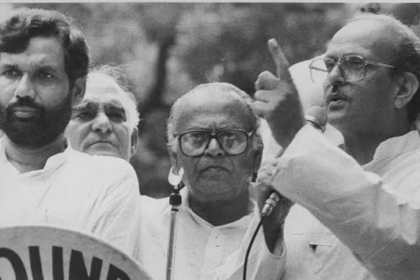Dharavi Redevelopment Update: Maharashtra chief minister Devendra Fadnavis has approved the Master Plan for Asia’s largest slum on May 28
The Dharavi Redevelopment Master Plan received the government approval on May 28, according to a statement from the office of Maharashtra Chief Minister Devendra Fadnavis. The approval was granted during a review meeting chaired by Fadnavis with senior officials.
Dharavi should be redeveloped in an environmentally friendly and integrated manner. The commercial turnover in Dharavi is the most important part, and every native resident of this place should be given a house,” reads a statement issued by Fadnavis’ office.
Fadnavis said the redevelopment of Dharavi should be environmentally sustainable and integrated, adding that economic activities in the area are of the utmost importance.
Maharashtra Deputy Chief Minister and Housing Minister Eknath Shinde directed all relevant departments to expedite the necessary approvals for the project. The meeting also included SVR Srinivas, Chief Executive Officer of the Dharavi Redevelopment Project, who delivered a detailed presentation on the initiative.
All about the Dharavi redevelopment project
Spanning over 600 acres, Dharavi is all set to undergo a facelift, with nearly 300 acres marked specifically for redevelopment and rehabilitation. In January 2024, Navbharat Mega Developers Private Limited (NMDPL)—a joint venture between the Government of Maharashtra and the Adani Group—appointed renowned architect Hafeez Contractor to lead the redevelopment initiative. The Master Plan will serve as a comprehensive blueprint for integrating residential, commercial, and industrial spaces while rehabilitating over 0.7 million residents. It aims to modernise infrastructure while preserving Dharavi’s socio-economic fabric.
As per Maharashtra’s Slum Rehabilitation Act, each eligible resident of Dharavi will receive one rehabilitation unit, regardless of the number of tenements they own. These units will be 350 sq. ft. in size—an upgrade from the 300 sq. ft. units provided in other slum redevelopment projects.Residents deemed ineligible for rehabilitation within Dharavi will be relocated to rental housing complexes outside the area under a hire-purchase arrangement.
Dharavi Redevelopment Project Pvt Ltd (DRPPL), now known as Navbharat Mega Developers Private Limited (NMDPL), is a joint venture between the Government of Maharashtra and the Adani Group. It is also known as ‘the largest urban rejuvenation project in the world’ and ‘the first step towards making Mumbai slum-free.’
In November 2022, the Adani Group emerged as the winning bidder, committing an initial investment of ₹5,069 crore to kickstart the long-awaited transformation.
In a landmark decision that could reshape the urban landscape of Mumbai, the Maharashtra Government has officially approved the Dharavi Redevelopment Project Master Plan. This long-awaited approval marks a crucial step forward in the transformation of one of Asia’s largest slums into a modern, sustainable, and dignified residential and commercial hub.
Spread over 600 acres, Dharavi has long been a symbol of Mumbai’s stark contrast between poverty and potential. For decades, governments and planners have debated how to redevelop the area while respecting the rights of its residents and maintaining the economic ecosystem that thrives within its narrow lanes. Now, with this master plan approval, the government is signaling its readiness to turn vision into action.
What Does the Dharavi Redevelopment Master Plan Entail?
The approved master plan aims to rehabilitate over 58,000 families and around 12,000 commercial establishments. The focus will be on constructing modern high-rise buildings with adequate infrastructure, sewage systems, open spaces, and public amenities. Residents will be offered new flats free of cost, provided they can prove their residence in Dharavi before the 2000 cut-off date.
The project is not merely about replacing shanties with skyscrapers — it’s about creating a vibrant community. Plans include schools, hospitals, parks, and commercial zones, all designed to uplift living standards and create economic opportunities. The rehabilitation will be done in phases to ensure minimal disruption to the people living there.
A Project Years in the Making
Redeveloping Dharavi has been a topic of discussion since the early 1990s. However, bureaucratic delays, legal challenges, and political roadblocks kept the project from taking off. In recent years, however, the Maharashtra government has renewed its focus on the initiative.
The current government has appointed a special-purpose vehicle (SPV) to execute the project, with international expertise also brought in for planning and infrastructure. The total investment is expected to exceed ₹20,000 crore, making it one of the most ambitious urban renewal projects in Indian history.
Balancing Progress and Preservation
One of the most critical challenges of this redevelopment is ensuring that the social and economic fabric of Dharavi isn’t lost in the process. Dharavi is not just a slum — it’s a self-sustained economy with thousands of micro-industries, from leather workshops and pottery units to recycling and garment businesses.
The master plan reportedly includes provisions to integrate these economic units into the redeveloped infrastructure. Commercial spaces and industrial zones will be allotted, allowing residents to continue their livelihoods in a more organized and hygienic environment.
Moreover, authorities have assured that the redevelopment will be inclusive and that no one will be forcibly evicted without proper rehabilitation.
Reactions from Residents and Experts
The response from Dharavi’s residents has been mixed. Many are hopeful that this redevelopment will finally provide them with permanent, safe homes. Others are skeptical, having witnessed several such promises in the past that never materialized.
Urban planners and real estate experts, however, see this as a significant move. “If implemented properly, the Dharavi redevelopment could be a model for urban renewal across India,” said one Mumbai-based architect. “It has the potential to create a blueprint for how we treat dense, informal settlements in growing cities.”
Economic and Social Impact
If successful, the project will have a massive economic impact — both locally and nationally. Real estate values around Dharavi are expected to rise. The redevelopment is also likely to generate thousands of jobs during the construction phase and beyond. Improved infrastructure, better hygiene, and safer living conditions will also lead to enhanced public health outcomes.
Socially, it can restore dignity to families that have lived for generations in cramped, often unsafe conditions. It’s a chance to turn the narrative of Dharavi from one of poverty to one of progress.
Also Read : Maharashtra Housing Policy 2025: Stamp Duty for Senior Living Homes Reduced to ₹1,000








